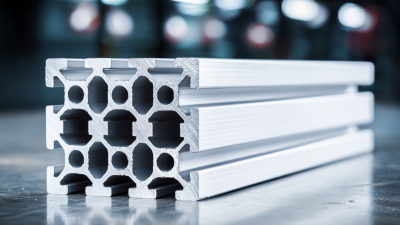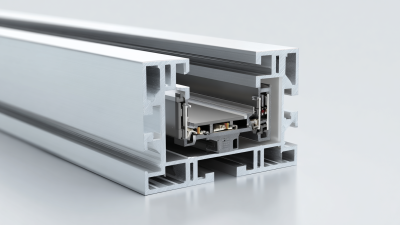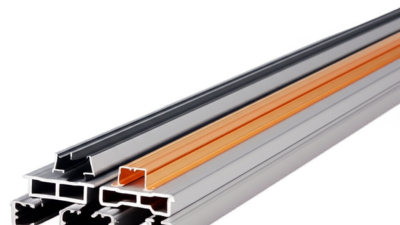In the rapidly evolving world of architecture, the use of Aluminum Extrusion Profiles is heralding a transformative phase that promises to redefine structural aesthetics and functionality. As architects and designers increasingly prioritize sustainable and innovative materials, aluminum extrusion stands out due to its unmatched versatility and strength. According to a recent report by the International Aluminum Institute, the global aluminum extrusion market is projected to reach USD 70 billion by 2025, driven largely by its applications in construction and infrastructure. This growth highlights a fundamental shift towards materials that not only enhance design possibilities but also align with eco-friendly practices.

Expert opinions further underscore this trend; Dr. Emily Hart, a leading specialist in materials engineering, notes, "Aluminum Extrusion Profiles are not just about structural integrity; they empower architects to push the boundaries of creativity while promoting sustainability." The capacity for these profiles to be custom-designed means that they can accommodate the most ambitious architectural visions, fostering a new era in modern architecture where form and function seamlessly converge. As we explore the top ten ways in which aluminum extrusion is revolutionizing architecture, it becomes clear that this material is at the forefront of redefining what is possible in the built environment.
The lightweight nature of aluminum extrusion profiles is reshaping sustainable architecture practices, offering architects and builders innovative solutions that prioritize both performance and environmental responsibility.
With its high strength-to-weight ratio, aluminum extrusion enables the creation of complex, aesthetically pleasing designs without compromising structural integrity. This flexibility allows for the use of larger spans and minimalist structures, reducing the need for excessive material usage and thereby limiting the overall carbon footprint of construction projects.
Moreover, aluminum’s recyclability enhances its sustainability appeal. As the industry moves toward greener building practices, incorporating extruded aluminum profiles contributes to circular economy principles. The extrusion process itself is energy-efficient compared to other manufacturing methods, and using recycled aluminum significantly decreases energy consumption. As North America and the Asia Pacific region continue to expand their aluminum extrusion markets, the integration of lightweight materials not only addresses the demands of modern design but also aligns with global sustainability goals, pushing the boundaries of what is possible in contemporary architecture.
Aluminum extrusion profiles are transforming modern architecture by offering innovative design solutions that blend functionality with aesthetics. According to the Aluminum Association, the use of aluminum in construction has surged significantly, with a projected market growth rate of 4.2% annually, reaching $41.3 billion by 2027. This trend is driven by the material's versatility, lightweight nature, and resistance to corrosion, making it an ideal choice for diverse architectural applications.
Case studies from around the world illustrate the impact of aluminum profiles in contemporary buildings. For instance, the EDGE in Amsterdam, one of the world’s greenest office buildings, employs aluminum facades that enhance energy efficiency and reduce operational costs. The integration of extruded aluminum not only contributes to the building's aesthetic appeal with sleek lines and modern finishes but also optimizes thermal performance and sustainability. Similarly, the new Apple Park campus in Cupertino utilizes aluminum panels to create a seamless and elegant design that complements the natural landscape while maintaining structural integrity, showcasing how aluminum profiles are enabling architects to push the boundaries of creativity and innovation.
This chart illustrates the utilization percentage of aluminum extrusion profiles across various building types in modern architecture, highlighting their growing significance in design solutions.
Aluminum extrusion techniques are transforming modern architecture by providing significant cost efficiency and energy savings. A report by the Aluminum Association indicates that extruded aluminum can reduce material waste by up to 30% compared to traditional materials. This reduction not only lowers production costs but also contributes to sustainable building practices. Engineered for strength, lightweight aluminum profiles allow architects to create expansive structures without compromising stability, ultimately leading to lower construction and maintenance expenses.
Moreover, the integration of aluminum extrusion profiles in building designs enhances energy efficiency. According to a study by the Lawrence Berkeley National Laboratory, buildings utilizing aluminum windows and doors can achieve energy savings of up to 25% in heating and cooling costs. The thermal break technology used in aluminum extrusion helps minimize heat transfer, ensuring that indoor climates remain stable while reducing the reliance on HVAC systems. As the demand for sustainable architecture grows, the cost-effectiveness and energy-saving attributes of aluminum extrusion will play an essential role in shaping the future of building design.
Aluminum extrusion has emerged as a game-changer in modern architecture, providing architects with unprecedented design versatility. As reported by the Aluminum Association, the global aluminum extrusion market is expected to grow to $50 billion by 2025, reflecting the increasing reliance on this material in construction and design. The unique properties of aluminum, including its lightweight nature, corrosion resistance, and ability to be molded into complex shapes, allow for innovative architectural solutions that were previously considered impractical.
The role of aluminum extrusion in expanding design possibilities is evident in the way it enables intricate facades, large span structures, and customizable components. According to a study by Freedonia Group, the demand for aluminum extrusions in architectural applications is projected to rise significantly, driven by the growing trend of sustainability and energy efficiency in building design. Architects are now able to experiment with unique shapes and forms, integrating aluminum components that not only enhance aesthetic appeal but also improve functionality, making it a favored choice for both modern residential and commercial projects.
| Dimension | Specification | Applications | Advantages |
|---|---|---|---|
| Thickness | 1.2 mm to 5 mm | Framing, Roof Structures | Lightweight, Durable |
| Width | 20 mm to 200 mm | Windows, Doors | Customizable, Aesthetic |
| Length | Up to 12 m | Curtain Walls, Canopies | Versatile, Sustainable |
| Shape | Custom Profiles | Architectural Elements | Innovative, Functional |
Advancements in aluminum extrusion technology are shaping the future of architecture by offering versatile solutions that cater to both aesthetic and functional needs.
The ability to create complex and customized profiles allows architects to push the boundaries of design, crafting structures that are not only visually striking but also optimized for performance.
Innovations such as improved alloy compositions and enhanced extrusion techniques have led to lighter, stronger, and more durable products, making aluminum an increasingly popular choice for modern building projects.
Moreover, the sustainability aspect of aluminum extrusion cannot be overlooked.
As environmental concerns become more pressing, architects and builders are turning to aluminum for its recyclability and energy efficiency.
The advancements in extrusion technology also facilitate practices like just-in-time manufacturing, which reduces waste and promotes a circular economy.
This convergence of advanced engineering and sustainable practices positions aluminum extrusion as a crucial player in the evolution of modern architecture, enabling the creation of not only iconic structures but also responsible ones.










